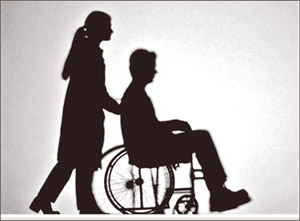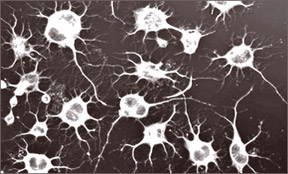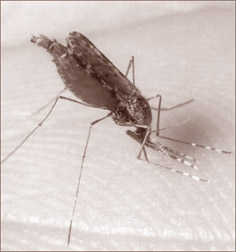|

Youth more at risk of spinal cord injuries
By Nilma DOLE
 |
Causes of spinal cord injury
1. Destruction from direct trauma
2. Compression by bone fragments, hematoma, or disk material
3. Ischemia from damage or impingement on the spinal arteries
4. Vascular disorders
5. Tumours
6. Infectious conditions
7. Spondylosis
8. Iatrogenic injuries, especially after spinal injections and
epidural catheter placement
9. Vertebral fractures secondary to osteoporosis
10. Developmental disorders
Courtesy: www.emedicine.medscape.com
|
Your spine is a delicate bone structure in your body which supports
your posture and is indeed your backbone supporting a whole host of your
bodily systems. People don't realise the value of their spine until they
fracture it accidentally or damage it. Once they are confined to a
wheelchair only do they realise the gravity of the fracture. Bread
winners and sole income earners are reduced to being immobile once an
accident takes place. Be it traumatic or non-traumatic, spinal cord
injuries affect individuals differently.
A seminar at the Health Education Bureau was held to understand more
about spinal cord injuries, statistics and what we must do to prevent
it. Spinal injury encompasses fracture, dislocation, nerve injury and
this results in disability as it depends on the level of severity. Part
of the central nervous system, the spinal cord is 10 millimetres in
width and 18 inches in length which is an extension of the brain and it
is the cord that communicates between the brain and the rest of the
body.
Government hospital consultant in Rheumatology and Rehabilitation
Medicine, Dr. Lilani Panangala said that spinal cord injury is a
devastating neurological injury resulting in varying degree of paralysis
sensory loss and uncontrollable bowel and bladder movements. She said,
"The causes of spinal cord injuries are domestic and industrial
accidents, road traffic accidents, sports injuries, self-harm and
criminal assault, war casualties and diseases such as tuberculosis,
transverse myelitis, neuro-degenerative conditions."
In Sri Lanka, 1,200-1,500 people are affected annually by spinal cord
injuries and the RRH (Rheumatology and Rehabilitation Medicine) at the
Ragama Hospital is the only specialised unit in Sri Lanka to help in
spinal cord injury therapy. Dr. Panangala said, "About 75 percent of
patients die within 18 to 24 hours of complications such as pressure
sores which can be avoided with the right education."
Moreover, the doctor said that effects of spinal cord injuries
encompasses spinal shock, loss of sensory and motor function below the
level of lesions, immobility, dependence on others, stress and worry.
She said, "Other fatal effects include sexual dysfunction (more in males
than in females) bowel and uncontrollable bladder and bowel movements
and high injuries can result in loss of involuntary functions such as
breathing difficulties.
However, there is hope for spinal cord injured patients as the RRH
does proper therapy and curative treatment to help cure such patients.
"The goals of rehabilitation offer education for patients and families
on this condition, we maximise proficiency in mobility and self care,"
she said. She said that by educating on other problems arising from
spinal cord injuries would help prevent the other conditions to follow.
A vital aspect of rehabilitation is counselling and psychological
assessment to talk about well-being and integration into the community
and vocational reintegration.
President of the Sri Lanka Orthopaedic Association Dr. G.L.
Punchihewa also spoke at the seminar. He said, "It is the young and
middle-aged population and males more than females who are more at risk
of spinal cord injuries. However, it varies from individual and what
occupational hazards and recreational activities the person does."
There is no magical cure for spinal cord injuries and it can't be
reversed but with the right therapy there could be some hope for
patients. "Out of those affected with spinal injuries, cervical (neck)
spine injuries amounts to 55 percent, thoracic spine injuries are 15
percent, thoracolumbar junction injuries encompass 15 percent and
Lumboscaral spine injuries is believed to be 15 percent," said Dr.
Punchihewa.
The primary step in initial injury is that it cannot be reversed as
there is no cure and the goal will be to prevent further injury to the
spine. "The patient should be immobilised and should be transferred to a
hospital immediately but improper handling and undue hurry may do more
harm than good," said the doctor.
Safe transport is a must and facilities should be in place with
trained paramedics on the job who know how to properly handle the
patient. "More often than not, if medical personnel do not get to the
scene of the accident immediately, ordinary people take matters into
their hands and cramp the victim in a three-wheeler in a bad position or
get the patient to sit upright in a fast-moving vehicle which would be
more fatal than benefit. This is due to lack of education and
awareness," said the doctor.Management at the hospital is done through
assessment of the damage and resuscitation, x-ray is taken of the spine
and if required, a MRI or CT scan if the injury is severe. "There is no
drug or miracle treatment to cure this condition but support mechanisms
will be fitted to the patient depending on the level of fracture," he
said.
Stabilisation of the spine is a necessity as it is required for early
mobilisation. "The outcome of spinal cord recovery can be either full
recovery or partial paralysis or to a certain degree," said the doctor.
The patient needs to rest and be stabilised after surgery and the
rehabilitation process should include physical, social and psychological
aspects. Occupational therapy and body weight supported treadmill
training that physiotherapists may assist with healing a patient with
spinal cord injury and also play an important role in the management of
this condition. "Social service is also imperative if we are to ensure
that spinal cord injury patients have a better tomorrow.
Also, prevention is better than cure so you could be a healthy and
fit individual but you shouldn't overdo things especially when it comes
to sports," said the doctor. Disability access in buildings, public
institutions and the homes of these patients should be enforced and even
though there are various measures in place, implementation is virtually
slow.
Lack of education and awareness also contribute and architects should
be mindful of designing buildings to accommodate disabled access.
Researchers on why steroid treatment for COPD is ineffective
 Chronic
obstructive pulmonary disease (COPD) leads to persistent inflammation of
the airways and is typically managed with corticosteroids, a class of
anti-inflammatory medication. However, corticosteroids do not improve
survival nor alter the progression of COPD and may reduce lung symptoms
as little as 20 percent. Chronic
obstructive pulmonary disease (COPD) leads to persistent inflammation of
the airways and is typically managed with corticosteroids, a class of
anti-inflammatory medication. However, corticosteroids do not improve
survival nor alter the progression of COPD and may reduce lung symptoms
as little as 20 percent.
A new study found why corticosteroids do not work well for COPD
patients and how additional treatment with sulforaphane an ingredient of
broccoli and other vegetables can improve the effectiveness of
corticosteroids.
COPD is a major public health problem for both the developed and the
developing world, and is most often caused by cigarette smoking or
exposure to pollutants from combustion. Characterized by chronic
bronchitis and emphysema, COPD is the third leading cause of death in
the U.S. and affects 24 million Americans and 210 million people
worldwide.
Histone deacetylase 2 (HDAC2) is critical component in a chain of
reactions that enable corticosteroids to reduce inflammation. However,
HDAC2 is substantially reduced in the lung tissue of individuals with
COPD.
In the study, researchers found that S-nitrosylation causes HDAC2
dysfunction and leads to corticosteroid insensitivity in the alveolar
macrophages of the lungs of individuals with COPD. S-nitrosylation of
HDAC2 occurs from exposure to cigarette smoke, a primary cause of COPD.
"This study provides the mechanism of exaggerated inflammation
observed in COPD patients during exacerbations, which has been a barrier
to developing effective therapy," said Rajesh Thimmulappa, PhD co-author
of the study and an assistant scientist in the Bloomberg School's
Department of Environmental Health Sciences. Furthermore, the research
team found that treatment with sulforaphane restored HDAC2 activity and
corticosteroid sensitivity.
Previous studies by the research team showed sulforaphane activates
the Nrf2 pathway (nuclear factor erythroid 2 related factor 2) and it is
being tested in clinical trial for patients with COPD.
Courtesy: Medical X Press
Cells are crawling all over our bodies
 For
better and for worse, human health depends on a cell's motility the
ability to crawl from place to place. In every human body, millions of
cells are crawling around doing mostly good deeds though if any of those
crawlers are cancerous, watch out. For
better and for worse, human health depends on a cell's motility the
ability to crawl from place to place. In every human body, millions of
cells are crawling around doing mostly good deeds though if any of those
crawlers are cancerous, watch out.
"This is not some horrible sci-fi movie come true but, instead,
normal cells carrying out their daily duties," said cell biologist Tom
Roberts. For 35 years he has studied the mechanical and molecular means
by which amorphous single cells purposefully propel themselves
throughout the body in amoeboid-like fashion absent muscles, bones or
brains.
Meanwhile, human cells don't give up their secrets easily. In the
body, they use the millions of tiny filaments found on their front ends
to push the front of their cytoskeletons forward. In rapid succession
the cells then retract their rears in a smooth, coordinated
extension-contraction manner that puts inchworms to shame. Yet take them
out of the body and put them under a microscope and the crawling changes
or stops.
But now Roberts and his research team have found a novel way around
uncooperative human cells.
In a landmark study led by Roberts and conducted in large part by his
then-FSU postdoctoral associate Katsuya Shimabukuro, researchers used
worm sperm to replicate cell motility in vitro in this case, on a
microscope slide.
Doing what no other scientists had ever successfully done before,
Shimabukuro disassembled and reconstituted a worm sperm cell, then
devised conditions to promote the cell's natural pull-push crawling
motions even in the unnatural conditions of a laboratory. Once launched,
the reconstituted machinery moved just like regular worm sperm do in a
natural setting giving scientists an unprecedented opportunity to watch
it move. Roberts called his former postdoc's signal achievement
"careful, clever work" and work it did, making possible new, revealing
images of cell motility that should help pinpoint with never-before-seen
precision just how cells crawl.
"Understanding how cells crawl is a big deal," Roberts said. "The
first line of defence against invading microorganisms, the remodelling
of bones, healing wounds in the skin and reconnecting of neuronal
circuits during regeneration of the nervous system all depend on the
capacity of specialized cells to crawl.
"On the downside, the ability of tumour cells to crawl around is a
contributing factor in the metastasis of malignancies," he said. "But we
believe our achievements in this latest round of basic research could
eventually aid in the development of therapies that target cell motility
in order to interfere with or block the metastasis of cancer." Funding
for Robert's worm-sperm study came from the National Institute of
Health. The findings are described in a paper ("Reconstitution of
Amoeboid Motility In Vitro Identifies a Motor-Independent Mechanism for
Cell Body Retraction") published online in the journal Current Biology.
Armed with the new found ability to reconstitute amoeboid motility in
vitro, cell biologists such as Roberts may be able to learn the answers
to some major moving questions. Among them: How can some cells continue
to crawl even after researchers have disabled their supply of myosin,
the force-producing "mover protein" that functions like a motor to help
power muscle and cell contraction?
For Roberts and his team, the next move will be to determine if what
they've learned about worm sperm also applies to more conventional
crawling cells, including tumour cells. "As always, there will be more
questions," Roberts said. "Are there multiple mechanisms collaborating
to drive cell body retraction? Is there redundancy built into the
motility systems?"
Courtesy: Science Daily
The body rids itself of damage when it really matters
Although the body is constantly replacing cells and cell
constituents, damage and imperfections accumulate over time. Cleanup
efforts are saved for when it really matters. Researchers from the
University of Gothenburg, Sweden, are able to show how the body rids
itself of damage when it is time to reproduce and create new life.
'I have a daughter. She is made of my cells yet has much less
cellular damage than my cells. Why didn't she inherit my cells including
the damaged proteins? That's the process I'm interested in,' says Malin
Hernebring from the Department of Cell- and Molecular Biology at the
University of Gothenburg.
A few days after conception, the cells in the embryo all look the
same - they are unspecified stem cells that can develop into any bodily
cell type. As the process of cell specification (differentiation)
begins, they go from being able to keep dividing infinitely to being
able to do so only a limited number of times. This is when they start
cleansing themselves.
'Quite unexpectedly we found that the level of protein damage was
relatively high in the embryo's unspecified cells, but then it decreased
dramatically.
A few days after the onset of cell differentiation, the protein
damage level had gone down by 80-90 percent. We think this is a result
of the damaged material being broken down.' In the past, researchers
have believed that the body keeps cells involved in reproduction
isolated and protected from damage. Now it has been shown that these
types of cells go through a rejuvenation process that rids them of the
inherited damage.
Some types of protein damage in the body increase with age. Although
all the necessary information is stored in the DNA, something keeps the
body from using it to keep repairing the body.
'These types of protein damages are what make us appear old, like
wrinkles around the eyes. While wrinkles are relatively harmless,
serious problems may arise elsewhere in the body. I'm thinking of
age-related diseases like Parkinson's, Alzheimer's, type 2 diabetes and
cancer.' Malin Hernebring can show that the damaged proteins in the
cells are probably broken down by molecular machines called proteasomes.
The proteasome activity increases considerably during the initial steps
of embryonic stem cell differentiation in mice. Deciphering this
rejuvenation process helps us better understand what ageing really is,
which in turn may help us slow it down and also prevent the occurrence
and ill effects of age-related diseases.
- e! science news
New Malaria vaccine to destroy world's most devastating killers
 Millions
of deaths a year could be prevented by a new malaria vaccine that has
been shown to cut the risk of disease in young children by half. Millions
of deaths a year could be prevented by a new malaria vaccine that has
been shown to cut the risk of disease in young children by half.
The initial results from a final stage of vaccine testing were
released last week, and the vaccine's developers hailed the results in
helping to tame one of the world's most devastating killers.
Bill Gates, whose foundation has contributed $1.75bn to the effort,
said it was a "huge milestone" in the fight against the disease.
"This is proof that it is possible to create a vaccine that is
effective against malaria," he said. He added that it "has the potential
to protect millions of children and save thousands of lives".
However, the vaccine won't be available for at least three years, as
crucial further testing must be completed to see how well it works in
infants and how long protection lasts. Then the vaccine must be reviewed
by government agencies in Europe and in individual African countries.
"We still have a way to go," Tsiri Agbenyega, lead researcher for the
African study, said in a conference call with reporters.
The early results, taken from a study in seven African countries,
show the vaccine is only about 50 per cent effective, significantly
lower than the protection seen in more common vaccines. But some experts
said it's a vast improvement on the current situation, and could still
save hundreds of thousands of lives.
Globally, malaria kills nearly a million people annually. More than
90 per cent of them live in Africa, and most are young children and
pregnant women.
Scientists have been trying for decades to develop a malaria vaccine
and the one tested is furthest along.
Without a vaccine, public health efforts have concentrated on malaria
drugs and other ways to prevent infection such as mosquito bed netting
and insecticides.
The new vaccine targets a malaria parasite found in sub-Saharan
Africa. Malaria spreads through mosquitoes, which bite people and flush
malaria parasites into the bloodstream.
The new study - still under way - began in 2009 and involves more
than 15,000 children in Burkina Faso, Gabon, Ghana, Kenya, Malawi,
Mozambique and Tanzania.
Early results were released yesterday at a malaria conference in
Seattle and published by The New England Journal of Medicine.
The findings focus on about 6,000 children aged five to 17 months.
A year after getting three doses, the vaccinated children had about
half as many cases of malaria as a group that didn't get the vaccine.
- The Independent
|

